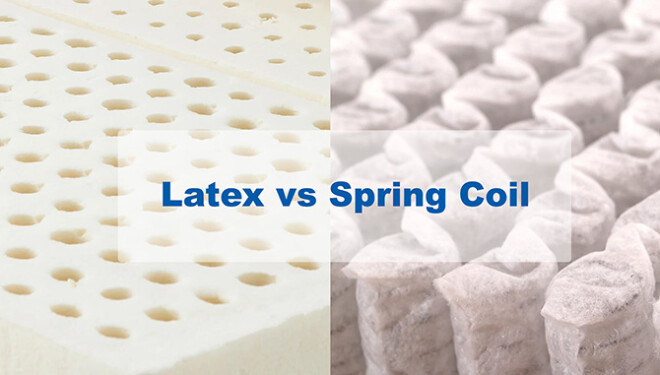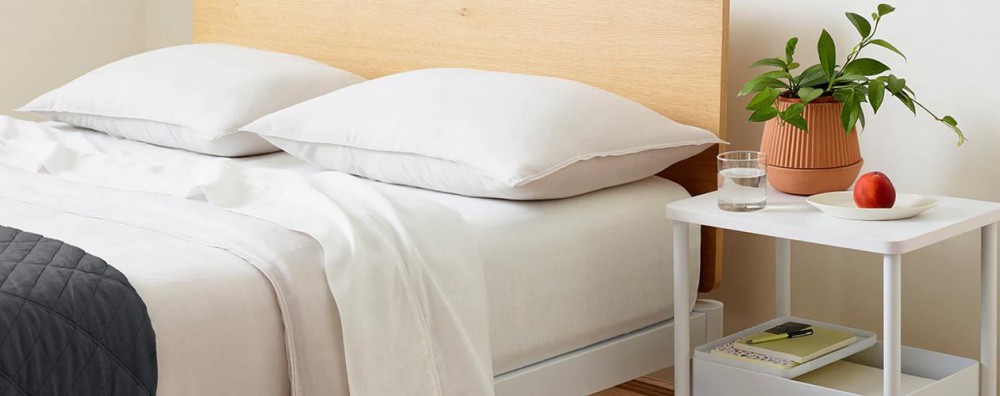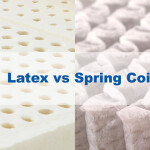Mattress Wars: Latex vs. Spring Coil

FacebookTwitterRedditPinterestEmailSleep Guide is reader-supported. When you buy through links on our site, we may earn an affiliate commission. In addition, we occasionally receive free product in exchange for our honest opinion. Learn more
You may have noticed lately that it seems as if we are in a mattress war. Our social media feeds are full of quirky sleep ads, and mattress boutiques dot the highways of many cities.
Some believe that the mattress debate is not over materials, cost or even levels of comfort. Support has long been noted as crucial for proper spine alignment and back health.
A mattress that is too soft might feel comfortable in short dose, such as a nap, but the lack of support can cause an unnatural position for many hours.
Which mattresses provide the most support? Typically, these are firm spring coil or latex mattresses. Unlike memory foam, which is renowned for softness, a spring coil or latex bed is more resilient. There may be less of an isolated, individual level of comfort — since memory foam conforms to a sleeper’s contours — but for those with back issues, the support provided by a firmer mattress cannot be beat.
We decided to take a deeper look into the two supportive mattress types in order to provide an unbiased evaluation to help your purchase decision. With a highly active and growing mattress market, it’s easy to get lost in the noise. Before we look more closely at the pros and cons of latex and spring coil mattresses, let’s consider sleep health and the state of the mattress industry today.
Sleep Health
We all know that sleep is important. It is restorative for both the body and the mind. While individual needs vary depending on activity level and general health, most doctors advocate for about eight hours sleep for adults.
Children and seniors may have additional or less sleep requirements, but even over the entire population, between seven and nine hours is an ideal goal. Of course, this refers to time actually sleeping, and not just lying in bed.
Supporting Bad Backs
Some people need extra comfort to get to sleep, and others need support. Sleep preference is highly subjective. Even doctors say there is no magic solution for back support. While many products are touted as the best for sore backs, including everyday items beyond mattresses such as shoe inserts, braces and more, there is little evidence that one product works for all types of pain.
But although the research is limited, there was a study that supported the use of a medium-firm mattress for back pain relief.
When to Buy a New Mattress
Mattresses typically last anywhere from eight to ten years, although this number depends on quality, durability and body size. Material also has a lot to do with longevity. Latex mattresses last around ten years, while memory foam and innerspring mattress last seven years or less.
Regardless of your specific comfort and health needs, you should make sure that you are updating your mattress before it becomes a health hazard. Note, too, that the older you get, the more you become susceptible to pressure points. So, if its been a while and you are getting past 40, it makes sense to look at a new mattress. Luckily, you have a lot of places to shop.
Mattress Market Today
Today, there are countless mattress options, with some estimating the total number of mattress manufacturers at close to 500. Furniture, department and specialty mattress stores offer a wide selection of traditional coil mattresses.
There are many price points and levels of comfort.
Most of the mattress buzz today is about different materials that can be delivered right to your front door. Since the early 2010s, it seems that a new mattress company appears every other day.
ALSO READ: 10 Genius Ways To Force Yourself Out of Bed
Although most of the new players in the mattress market are the bed-in-a-box solutions that are heavily advertised online, latex mattresses only make up a small portion of these products, and spring mattresses are completely outside of this niche. Most of these mattresses are memory foam, but an increasing amount are made out of latex.
Latex Mattress Construction
What, exactly, is a latex bed? The best general definition is a mattress constructed wholly or partly out of natural or synthetic latex, although most are made with natural materials. Natural latex comes from the rubber tree plant, mostly from trees that grow in Indonesia, Malaysia, Thailand and Sri Lanka.
The liquid latex is extracted, processed and cooled to form rubber. Some of these mattresses are thick slabs of latex, and some are combinations of different mattress materials with an integrated latex topper.
Synthetic latex is normally natural latex that has been combined with plasticizers to stretch it a bit. Some latex mattresses are made of a blend of synthetic latex with natural latex, with some added fillers and stabilizers such as clay. Once you start adding adjuncts to your latex mattress, the result is a less durable and stiffer product that is cheaper.
Although all natural latex is the same product, not all latex is made the same. There are two main latex production methods used in bedding today, Dunlop and Talalay.
Dunlop latex
Dunlop latex is a process that has been in use since the 1920s. The process essentially involves frothing up latex so that it is aerated, then steaming it to a solid block that dries in a mold that contains pin-like protrusions. The resulting latex is a dense foam with a lot of bounce. It is firm and extremely durable. A Dunlop latex mattress can also be heavier than other latex mattresses. It also can be less forgiving, and can also feel hot as the material absorbs body heat.
Talalay latex
The second popular method for manufacturing mattress latex is called the Talalay process. Again, the same type of latex material is used, it is just processed differently. After being whipped into a froth, the latex is subjected to a vacuum chamber, which extracts air. Air is then reintroduced in a controlled ratio based on the desired level of firmness. Then, the material is flash frozen. After complete, the process produces a softer mattress layer.
Brands
While there are not as many brands of latex mattresses, it is a growing sector in the market. Some of the popular brands include:
- Zenhaven
- Roma
- Sleep EZ
- Pure Latex Bliss
- Nest Bedding
- Foam Sweet Foam
Price Range
Latex mattresses tend to be costlier than most memory foam mattresses and some spring coil brands. This is because as a natural product with a labor-intensive process, latex requires more labor to create. While there are some bargains available, such as the Roma mattress for around $750, these mattresses usually start closer to $2,000 at the low end and up to $4,000 for a luxury, organic product.
The prices vary based on mattress depth as well, with a thicker 13-inch mattress typically costing much more than a 9-inch style.
Other Features and Considerations
Since latex is a natural product, it is good option for those looking for an organic mattress. Not all-natural latex is organic, however, since the molding process can require additional chemicals. Currently, only Dunlop process latex is available in organic. Manufacturers are hoping to develop an organic process for Talalay shortly.
Since most latex mattresses use a blend of foams using both processes, until organic Talalay becomes available, organic options will be limited.
Spring Coil Mattress Construction
You might think that all spring mattresses are the same. They use technology from over a century ago, and if you pay attention to the barrage of memory foam advertisements online and on TV, the only advances have been to more futuristic materials.
ALSO READ: Remembering Your Dreams. Here’s How.
This is not necessarily the case, as mattress companies have employed numerous design changes to optimize comfort and support. One of these is moving from linked coil springs to individual pocket springs. Here’s what these two types of spring mattresses are all about:
Coil Spring
A coil spring is what many consider a traditional mattress. If you were to crack open the mattress that you grew up with, you’d find a mesh of many interlinked springs. These springs are metal and work together to provide a bouncy and supportive mattress feel. There are some major drawbacks with coil springs. First, since the springs are interlinked, there is a lot of motion transfer. If your sleeping partner moves around a lot, you will feel their every miniscule motion.
Pocket Spring
For a step up in innerspring mattress performance, there are individually wrapped pocket springs. Some manufacturers call this style of mattress pocket spring, while others use the term “encased coil.” This type of mattress construction uses metal springs that are independent of each other, resulting in greatly reduced motion transfer.
Instead of one large spring, every few inches of your body has its own support. While they may sound like a recent innovation, the technology was developed by James Marshall in 1899. For this reason, pocket springs are also called Marshall Coils.
These pocket springs are wrapped in a fabric sleeve, ensuring that the springs do not connect together, which would defeat their purpose. People like the feel of pocket spring mattresses for many of the same reasons that they like memory foam mattresses.
The individual support and comfort and lack of motion transfer are the same features and benefits found in modern memory foam. Pocket springs have the added benefit of not giving a “lost at sea” feeling, or the feeling of being trapped in quicksand that some experience with memory foam.
When it comes down to providing a quality night’s sleep with less discomfort and more support, individual pocket spring construction is the best option.
Brands
Although there are over 100 brands of bed-in-a-box mattresses, there are several hundred traditional spring coil mattress brands. Since we believe pocket springs to be the superior spring coil product, we have focused our review on those that provide individually wrapped spring comfort.
Some of the popular brands of pocket spring mattresses include:
- Simmons Beautyrest
- Serta iSeries
- Sterling
- Gold Bond Sacro
- Hampton and Rhodes
- Sleepy’s
Price Range
The price range for pocket coil mattresses is from $500 on the low end and $3,000 for a more luxurious model with additional features such as a pillow or plush top. As with many traditional mattress options, pocket coil mattress price depends on brand, quality and materials.
Comparison Between Latex and Spring Coil Mattresses
Which mattress provides the most supportive comfort? For the answer, we chose to grade each mattress style based on several factors, including: comfort, support, edge support, temperature, durability, and odor.
Comfort
How good a mattress feels is subjective. Some people like to sleep on a pile of feathers, and others like harder slab. Many report excellent comfort experiences with both mattress types. Neither suffers from some of the comfort issues associated with memory foam. Talalay-method latex mattress tops, however, are luxurious. Instead of numerous individual coils, there are millions of points of comfort in latex foam.
Support
Both offer excellent support, too. Springs are responsive, but latex adds a some bounce. For those who worry about memory foam’s sunken feeling, both mattress types will provide surdyness. But coils springs can over-compress and wear out over time.
Edge Support
One area in which individually wrapped spring coils are lacking is edge support. Edge support is the ability to sit on the side of the bed comfortably, without sinking into the mattress. Traditional innerspring mattresses without individual coils feel unified and sturdy, which results in strong edge support. Some foam mattresses use higher density foam at the edges to increase edge support, but it’s not quite the same feeling as sturdy coil.
ALSO READ: 5 Natural Remedies to Help You Fall Asleep Sans Medication
Temperature
Any innerspring mattress is made up of a lot of air. It’s between the coils, and it’s among the cushioning fibers. This allows for circulation and ventilation. Latex foam is less breathable; therefore it tends to absorb not only a sleeper’s weight, but body temperature, too. Because of this, a latex foam bed can provide a warmer sleep experience. Some people like this feeling, while others want it cooler.
Some latex mattress companies counter the temperature issue with cooling gel layers and different methods of stacking foams of different strengths.
Durability
Latex wins the durability test for any mattress material. Well-made products rarely disintegrate. Innerspring mattress wear with age. The fabric shifts, springs sag, and over time, your body makes an indelible impression. If you like to push the limits of mattress lifespan, steer clear of innersprings. Even the best brands last no longer than seven years before they show signs of sagging.
Odor
While latex is very durable, it also has a certain odor. The somewhat chemical smell only lasts for the first few weeks, but for some, it is troubling. A new innerspring mattress just smells new. Also, there are several ways to speed up the off-gassing process, such as keeping the mattress in a well-ventilated area. Then again, the smell of latex doesn’t bother everyone.
A Third Choice – Hybrid Mattresses
When it comes to balancing comfort and support, there is a third choice. Today’s new mattress products include hybrids of the two styles. With firm individual coils for support, and a few layers of foam for added support, comfort and durability, yo can experience the best of both worlds. You still have to content with the odor and possible night sweats, but this is also minimized as usually these have thinner latex layers.
Some hybrid mattresses even include a touch of memory foam for some added comfort, without sacrificed support. The only negative about a hybrid mattress is that they aren’t delivered in a sleek box at your doorstep, all rolled up. But with hybrid mattresses available at every mattress and furniture store, they are readily available.
Our Verdict: Which is the Best Mattress for Support?
Between latex and spring coil mattresses, we choose latex. The comfort is unbelievable, and the responsiveness provides stellar support. Buying a latex mattress is convenient, with online offers for free shipping and 100 day-plus free trial periods. And the future of latex looks good. People are embracing natural and organic latex materials, and the support, comfort and convenience.
We also like the idea of the hybrid mattress, but also keep thinking from another perspective — you also experience the negatives of each mattress. In a way, a hybrid can be worse than either alone.
Final Note: Delivery
One last thing to remember about mattress shopping is how to not only get the bed home, but what to do with any old mattress you may own. When you buy a mattress from the furniture or mattress store, it’s almost assumed that the negotiated price will include setup and removal of your old mattress.
When you shop online, you don’t always have this option. Some mattress companies provide “white-glove” delivery, which includes setup and removal, while others charge a premium for the service, up to $150. If getting rid of a mattress is important to you, make sure to include this fee in your choice.
Good luck in your search for optimal sleep. With all the options available, mattress shopping is no longer simple.

Source: Internet





